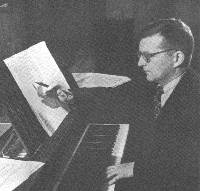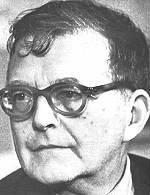Dmitri Shostakovich (1906 - 1975)
 (born
St. Petersburg, 25 September 1906; died Moscow, 9 August 1975).
(born
St. Petersburg, 25 September 1906; died Moscow, 9 August 1975).
He studied with his mother, a professional pianist, and then with Shteynberg
at the Petrograd Conservatory (1919-25): his graduation piece was his Symphony
no.1, which brought him early international attention. His creative development,
however, was determined more by events at home. Like
many Soviet composers of his generation, he tried to reconcile the musical
revolutions of his time with the urge to give a voice to revolutionary
socialism, most conspicuously in his next two symphonies, no.2 ('To
October') and no.3 ('The First of May'), both with choral finales. At the
same time he used what he knew of contemporary Western music (perhaps Prokofiev
and Krenek mostly) to give a sharp grotesqueness
and mechanical movement to his operatic satire "The Nose", while
expressing a similar keen irony in major works for the ballet
("The Age of Gold", "The Bolt") and the cinema
("New Babylon"). But the culminating achievement of these quick-witted,
nervy years was his second opera
"The Lady Macbeth of the Mtsensk District", where
high emotion and acid parody are brought together in a score of
immense brilliance.
 "Lady
Macbeth" was received with acclaim in Russia, western Europe and the USA,
and might have seemed to confirm Shostakovich as essentially a dramatic
composer: by the time he was 30, in 1936, he was known for two operas and
three full-length ballets, besides numerous scores for the theatre and
films, whereas only one purely orchestral symphony
had been performed, and one string
quartet. However,
in that same year "Lady Macbeth" was fiercely attacked
in Pravda, and he set aside his completed Symphony no.4 (it was
not performed until 1961), no doubt fearing that its Mahlerian
intensity and complexity would spur further criticism. Instead he began
a new symphony, no.5, much more conventional in its form and tunefulness
- though there is a case for hearing the finale as an internal send-up
of the heroic style. This was received favourably, by the state and indeed
by Shostakovich's international public, and seems to have turned him from
the theatre to the concert hall. There were to be
no more operas or ballets, excepting a comedy and a revision of
Lady Macbeth; instead he devoted himself to symphonies,
concertos, quartets and songs
(as well as heroic, exhortatory cantatas during the war years).
"Lady
Macbeth" was received with acclaim in Russia, western Europe and the USA,
and might have seemed to confirm Shostakovich as essentially a dramatic
composer: by the time he was 30, in 1936, he was known for two operas and
three full-length ballets, besides numerous scores for the theatre and
films, whereas only one purely orchestral symphony
had been performed, and one string
quartet. However,
in that same year "Lady Macbeth" was fiercely attacked
in Pravda, and he set aside his completed Symphony no.4 (it was
not performed until 1961), no doubt fearing that its Mahlerian
intensity and complexity would spur further criticism. Instead he began
a new symphony, no.5, much more conventional in its form and tunefulness
- though there is a case for hearing the finale as an internal send-up
of the heroic style. This was received favourably, by the state and indeed
by Shostakovich's international public, and seems to have turned him from
the theatre to the concert hall. There were to be
no more operas or ballets, excepting a comedy and a revision of
Lady Macbeth; instead he devoted himself to symphonies,
concertos, quartets and songs
(as well as heroic, exhortatory cantatas during the war years).
Of the next four symphonies, no.7 is an epic with an uplifting war-victory
programme (it was begun in besieged Leningrad), while the others display
more openly a dichotomy between optimism and introspective doubt, expressed
with varying shades of irony. It has been easy to explain this in terms
of Shostakovich's position as a public artist in the USSR during the age
of socialist realism, but the divisions and ironies in his music go back
to his earliest works and seem inseparable from the very nature
of his harmony, characterized by a severely weakened sense of key.
Even so, his position in official Soviet music certainly was difficult.
In 1948 he was condemned again, and for five years he wrote little besides
patriotic cantatas and private
music (quartets, the 24 Preludes and Fugues which constitute his outstanding
piano work).
Stalin's death in 1953 opened the way to a less
rigid aesthetic, and Shostakovich returned to the symphony triumphantly
with no.10. Nos.11 and 12 are both programme
works on crucial years in revolutionary history (1905 and 1917), but then
no.13 was his most outspokenly critical work, incorporating a setting of
words that attack anti-semitism. The last two symphonies and the last four
quartets, as well as other chamber pieces and songs, belong to a late
period of spare texture, slowness and gravity, often used explicitly in
images of death: Symphony no.14 is a song cycle on mortality, though
no.15 remains more enigmatic in its open quotations from Rossini
and Wagner.
 "Lady
Macbeth" was received with acclaim in Russia, western Europe and the USA,
and might have seemed to confirm Shostakovich as essentially a dramatic
composer: by the time he was 30, in 1936, he was known for two operas and
three full-length ballets, besides numerous scores for the theatre and
films, whereas only one purely orchestral symphony
had been performed, and one string
quartet. However,
in that same year "Lady Macbeth" was fiercely attacked
in Pravda, and he set aside his completed Symphony no.4 (it was
not performed until 1961), no doubt fearing that its Mahlerian
intensity and complexity would spur further criticism. Instead he began
a new symphony, no.5, much more conventional in its form and tunefulness
- though there is a case for hearing the finale as an internal send-up
of the heroic style. This was received favourably, by the state and indeed
by Shostakovich's international public, and seems to have turned him from
the theatre to the concert hall. There were to be
no more operas or ballets, excepting a comedy and a revision of
Lady Macbeth; instead he devoted himself to symphonies,
concertos, quartets and songs
(as well as heroic, exhortatory cantatas during the war years).
"Lady
Macbeth" was received with acclaim in Russia, western Europe and the USA,
and might have seemed to confirm Shostakovich as essentially a dramatic
composer: by the time he was 30, in 1936, he was known for two operas and
three full-length ballets, besides numerous scores for the theatre and
films, whereas only one purely orchestral symphony
had been performed, and one string
quartet. However,
in that same year "Lady Macbeth" was fiercely attacked
in Pravda, and he set aside his completed Symphony no.4 (it was
not performed until 1961), no doubt fearing that its Mahlerian
intensity and complexity would spur further criticism. Instead he began
a new symphony, no.5, much more conventional in its form and tunefulness
- though there is a case for hearing the finale as an internal send-up
of the heroic style. This was received favourably, by the state and indeed
by Shostakovich's international public, and seems to have turned him from
the theatre to the concert hall. There were to be
no more operas or ballets, excepting a comedy and a revision of
Lady Macbeth; instead he devoted himself to symphonies,
concertos, quartets and songs
(as well as heroic, exhortatory cantatas during the war years).
 (born
St. Petersburg, 25 September 1906; died Moscow, 9 August 1975).
(born
St. Petersburg, 25 September 1906; died Moscow, 9 August 1975).